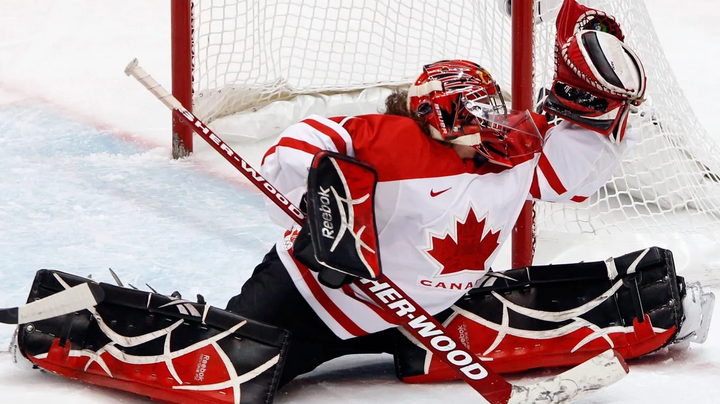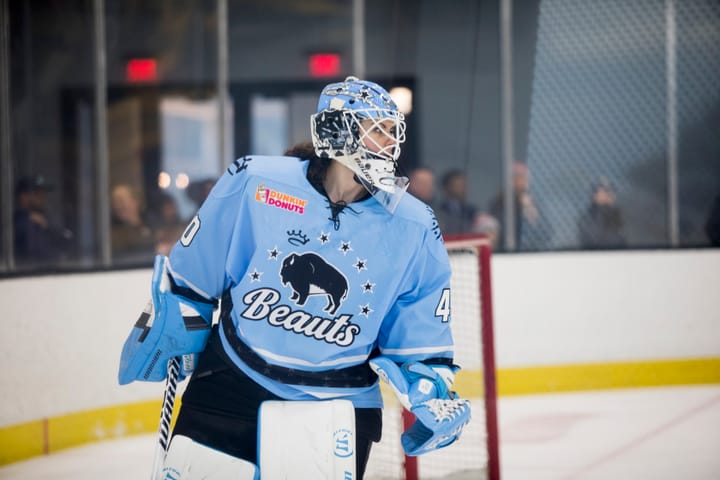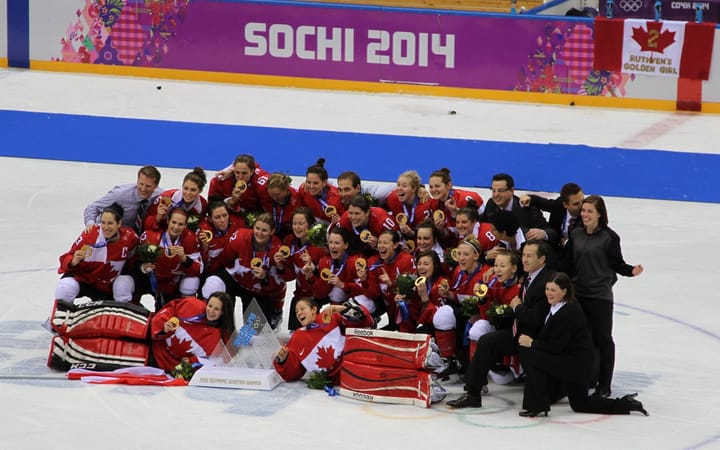Q&A with Anya Battaglino
The NWHLPA’s Executive Director discusses her perspective on the #ForTheGame movement.
Following Thursday’s announcement that over 200 players plan to boycott the 2019-20 North American hockey season, NWHLPA director Anya Battaglino released a statement in which she described this movement as a fragmentation that will slow the growth of the game.
The Ice Garden spoke with Battaglino to gain a better understanding of her and the NWHLPA’s perspective on these developments.
The Ice Garden: Could you give us an overview from your side of things of how the #ForTheGame movement has progressed?
Anya Battaglino: On Saturday this past weekend, I started hearing from players letting me know that some national team players were reaching out and asking them to withhold services. I hear that information while I’m also working actively with the CWHLPA to understand how to serve everyone’s best interests during our contract negotiations.
On Monday evening I scheduled a call with NWHL leadership, an unnamed investor, an investor that everyone knows of, Dani Rylan, and Hayley Moore to allow players to hear a little bit about our initiatives, better understand the NWHL’s position, and then to have a question-and-answer. I invited all the players in the NWHL and then forwarded that email to the CWHLPA’s head Liz Knox. On the call we had a pretty substantial number of folks.
The follow-up to that got pretty fiery pretty quickly and it was apparent to me that the climate of the call was not to better understand the way to move forward, but to try to ward people from supporting the league.
On Tuesday and Wednesday there were constant updates from players on both sides of the fence, what was said, and what was being told to them, and on Thursday, at 11, the release came out.
Related
A Timeline of the #ForTheGame Movement
TIG: Did any of the organizers of #ForTheGame reach out to you personally to try to recruit you?
Battaglino: No. Neither to myself nor my legal staff. Nobody was privy to the information directly from any of the figureheads in that space on potential contract wants, or negotiation tactics, or desired outcome moving forward.
TIG: What was the initial reaction from the folks at the NWHL like?
Battaglino: I think that I can only speak for myself. For me I was very frustrated, but I know that there’s two sides of this— the business side and the personal side. A lot of the information that was being said to players, to me, seemed really personal. It didn’t seem so much as much of a business initiative.
I myself was not nearly as personally hurt because I’m only acting in the interest of the players. If the players say I want a higher salary cap, I want XYZ, they create a list demands, I’m still in those contract negotiations. No one can point to the PA’s role or function and say you didn’t do your job because it’s not finished. There’s still negotiations going on between the NWHL and PA because I believe that the players want the best possible contract. Some have outwardly come out and said they just won’t play in the NWHL, but if there’s a way I can get forward progression on that contract, maybe it is the right thing to do, so I’m not doing to rest until we’ve gotten a contract offer for 19-20 for players to reject. Right now there’s not anything in front of them to reject, which makes it frustrating for me.
TIG: Were you surprised at how quickly the movement came together and how many people jumped on board?
Battaglino: Yes, because the number-one chief complaint about the NWHL has been a lack of information, and this movement couldn’t have less information associated with it. So it’s just this complaint of “we want more clarity and information” and then “we hope to hold out for the promise of something we don’t know any details about.”
I know that there’s two sides of this— the business side and the personal side.
So for me, it was interesting that everybody got on board so quickly when we’re dealing with contracts and hard evidence and progression, and teams, location, and data that exist, and it’s the idea of throwing that all into the fire for a salary, structure, and backing that’s unknown.
Players are hoping for more and I agree; I believe that players deserve more. But the main interest from some of these organizing people is in having interest in a full-time league, and they get income from their national team or sponsorships that they may have, and the people that they’re trying to get to support them are teachers, architects, sales people, in careers that they will have to drop to then get even $25,000-$30,000.
Once the game is over, if you don’t have the basis of a career to lean back on— there’s the hope that even if the salary is $60,000, it’s just challenging to ask players to leave their careers at this time.
Related
A list of players involved in #ForTheGame
TIG: Can you elaborate on what kind of changes are you making in the Players Association this year?
Battaglino: We’ve made the contract ourselves and we’ve gotten a lot more clarity on what exactly the words should mean. We’re further increasing salaries as well as creating a different income stream and revenue stream. We’re also working on more gear.
There are different things that are on the table right now, and insurance is one of the things we want to bring to the forefront given the resounding feedback. Unfortunately in the process we ask all of these players to give us actual terms regarding what they will or will not play without, and right now the only way we’re getting this data is through the boycott.
TIG: Could you expand on some of the initiatives from the NWHL press release, such as the 50/50 revenue from sponsorships and media deals?
Battaglino: The program will be: any league-wide sponsor or media partner that we procure will be handled by a third-party on a deal-by-deal level, and then the PA will have access to be able to speak to that party directly so we have full transparency.
For example, if a deal comes in at a million dollars, the league would take their cut of half a million dollars and then if any fees were to apply with the third-party agency, then that would come out of the league’s 50 percent. Of the player’s 50 percent it would be divided among the teams who would get that lump sum and then pay their players on percentage of salary cap. So if you negotiated ten percent of the salary cap, then you would get ten percent of that team’s allocated revenue split. So it doesn’t go equally to all the players; however, the goal is that it benefits you as much as the percent of the cap that you have. If you’re making minimum wage, you could potentially double that, or triple that.
TIG: What are you doing within the PA to responding to various mentions from players about a lack of trust in the league?
Battaglino: It’s hugely important to me to find a communication strategy that empowers players so they don’t feel like they aren’t being heard. That means asking better questions and trying to understand what information will instill that confidence.
Often we hear them saying that there’s an unsustainable business model, but what I want to understand from the players what they think that means. Are they using that terminology because it sounds appealing to them, or do they understand the business structure and not like it? If they don’t, then let’s try to educate them and try to get them understanding how we’re procuring investors and what trends are increasing. Just saying that they want the numbers isn’t a question, and it gets really challenging to try to get the business to just give up the numbers because that doesn’t make business sense to do that at this point, because any company before going IPO doesn’t release that information.
I get both sides because I was formerly a player. At what, point are we asking, hey, what has been our growth metric or where is our biggest loss? Some of those questions could be very impactful, and if that’s what the players want, I urge them to come forward and ask those questions. Just saying that the business model is unreliable without having follow-up questions isn’t getting us information or making conversation.
What I’m trying to do is better explain that this is an invested company that is selling tickets, jerseys— I don’t know what about this structure is different from the NHL aside from actually having NHL backing. It’s just a matter of finding out what resources are needed and what to provide more of.
Look at how powerful Women’s Hockey voices are when UNIFIED. Imagine if it read, “United to PLAY in North America.” We could drive unprecedented growth and affect change + structure that increases benefits and pay! We’ve never had #OneLeague, never tested this product. https://t.co/XG0gwjUVFH
— Anya Battaglino (@battaglinoa) May 2, 2019
I personally live in Connecticut, so I was able to procure Greenwich Sports Medicine, who gave us access to their chiropractors and doctors for rehab and all we had to do was mention it. So, how do we strike up better deals like that to give players access to better resources? It all comes down to a question.
So, all of this becomes a question of, let’s better understand what makes your life an all-time high, and let’s give you that and get you there.
TIG: How important has it been for you to be working with the CWHLPA right now?
Battaglino: If I can hear and understand, that helps— and I played in the CWHL. I didn’t play when they were paid, but there’s this general progression that year one of being paid is great, but year two of being paid in either league is crappy. So how do I solve those problems and work out what those challenges were?
I think that any conversation we can have with a unified group of people that has lived through women’s hockey is the life blood of what we’re doing.
I’ve identified that their main challenges were one, amount— absolutely— but they didn’t seem to have the same benefit structure, but further, they had a huge transparency issue and that is the biggest sticking point of hesitation for all of those players. So I’m asking the right questions as to what data will provide you the confidence so you won’t feel like you’re left in the dark, and what data isn’t helping you?
Whether they stand right now with the #ForTheGame movement or if they’re waiting for this contract— the worst-case scenario is that we could all collaborate and get a contract with the NWHL and the players still reject it. But at this point I would like to negotiate the best possible contract so we can use this movement to further develop the league that we already have access to.
So much respect between the @CWHLPA and @NWHLPA. Progress is made together, and I will still continue to provide an open line of communication with all. @27Knoxy @alexis_millller https://t.co/93W7yQLBLE
— Anya Battaglino (@battaglinoa) May 2, 2019
TIG: What other action steps do you want to take with the PA before the 2019-20 season begins?
Battaglino: My main action plan is to provide transparency, and that has nothing to do with the contract and everything to do with understanding how to operate this business. If we could create the infrastructure to have a monthly or quarterly call with investors, where we say this is working, this isn’t, even if we’d need to get NDAs or confidentiality— if we could do that for our players, we could instill that confidence moving forward. That’s where my brain has been going a mile a minute— how do we create the infrastructure to create a call or a debrief? How do we provide players with that data? I’m trying to bridge that gap right now.
If nothing else, this movement has shown us that people want to talk about this, they want to understand, and they want to be agents of change. All of that is powerful. Now that we have companies leaning in and people willing to open the dialogue, how do we leverage all of that to be a driving force? That should be something that we get and move forward with, we become more investable. Sponsors want to be involved. What opening do we create by being more collaborative? That’s what I’m trying to get from this.
TIG: Obviously you can’t speak for players who haven’t said anything about this movement yet, but how do you think they might be feeling?
Battaglino: I think that there’s a lot of hesitation, but it seems like most of the negatives aimed toward the NWHL come from players who aren’t in the NWHL right now, or haven’t been for the past two seasons. I’m not saying it’s me being head of the PA, or Dani bringing Hayley on, or our lawyers being on top of it— I don’t know what the secret sauce is, but the infrastructure has changed very greatly for the better. A lot of the negative speech about the NWHL unfortunately comes from people being misguided and I’m trying to bridge that gap.
I find that players who have lived through the NWHL from seasons one through four understand the growth because they’ve seen the positives, watching people get involved, seeing the increase in benefits. Those small players make a world of difference for the players working every single day to make things better, and I think it’s very challenging that they’re being forced out of their role without really knowing the data that they are choosing.
I think it’s hard. It’s really hard. I get it, and I respect wanting more, and I want more for every single player, every single day. My goal is to get that, but I just want to make sure we’re doing that in the way that’s most effective.
Related
How We Got from #OneLeague to #ForTheGame
TIG: How optimistic are you that the PA, the NWHL, and the members of this strike can find common ground before the 2019-20 season begins?
Battaglino: That’s a really hard question.
I believe that our best chance of bridging this gap comes from a large vote of confidence from players that want actual change now. I think that there’s a hesitation in the market to forgo women’s hockey and allow it to collapse entirely and hope that the next start of it will be the best possible case. I think that players will think critically. I lived through the CWHL as it grew, and the NWHL as it grew, and growing pains hurt.
I wonder if we should find a way to present the best possible contract that we could possibly present to get people on board, even if we need to to use “if, then” statements— you know, like, “this sponsor will come on board if we all join, and then we are unified.” Things like that bring us a level of gravitas to say, “okay, person holding out, you will be part of what brings this six-figure deal across the line.”
You can’t have your movement just say, women’s hockey folds and then hopefully re-surges. But, if we have some amount of opportunities and move forward all together, maybe that’s how their movement can create change. There has to be a positive option on both sides of the fence. It can’t just be fold and then they’ve succeeded. I don’t know what the answer is, but I hope in some way we can find some kind of action plan that gives the movement what they want but also get players out of this retirement.
TIG: How’s the wedding planning going?
Battaglino: I think women’s hockey knows when Madison and I have anything exciting going on! The CWHL folded on a Sunday when Madison and I were going on vacation on Tuesday. Then this whole thing happened on Thursday and today Madison has her suit fitting. Tomorrow we have our wedding menu tasting, and Sunday I have my bridal shower.
I’m hoping by the wedding on August 16, this will all be sorted. If women’s hockey could just give me that one, I’ll be ecstatic!





Comments ()